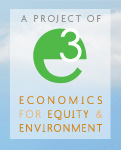John ‘Skip” Laitner is an economist, enjoying a desert year while on research sabbatical from the American Council for an Energy-Efficient Economy. Skip is discovering some surprising insights from his time in the desert that can inform the way one looks at the economy and social systems.
In the Sonoran Desert the bizarre is very real. The heat of the sun and the harshness of the environment have forged an amazing assortment of wonderfully complex and adaptive life forms.
The jumping cholla, or teddy bear cholla, resembles a cuddly plant with soft arms which, as you look closer, are completely covered with golden and silvery spines that seem to jump off the plant at the slightest touch. Ouch! And there are the javelinas that, yes, look like wild pigs but which are actually members of the peccary family, a group of hooved mammals originating not in Eurasia but in South America. And, of course, there is Boojum tree which must be among the most strange spiny upside down carrots most people have never seen.
Yes, there are some very strange things to be seen wandering out on the desert floor. But there is also a collection of very strange sights that tug at my mind – strange not because they’ve assumed a curious shape, but because they are so surprisingly common and so out of place: a couple of orange peels, or empty water bottles, streams of paper fragments, an old mattress, and of all things, a used condom hanging off the branch of a creosote bush.
From time to time, the sight of these many and clearly out-of-place things do get me to wondering. And I forced to conclude that our standard of living may be more the result of our garbage and trash than our vaunted Yankee ingenuity.
This year our personal income in the U.S. will approach 12.7 trillion dollars, averaging about $41,000 per person. At the same time, we will generate an estimated 260 million tons of garbage, including all forms of industrial, agricultural and municipal solid wastes. That is about 1,700 pounds of garbage in this year alone for each person living within the United States. My own calculations suggest that we generate enough municipal waste each day to fill 60,000 trucks with garbage.
Among the wastes? Yes, they include the usual stuff we might imagine: old tires, used clothing, construction debris, broken household furniture, and the like. But it also includes everything from unused drugs to significant amounts of food wastes. Every year, for example, vast quantities of pharmaceuticals are thrown away by hospitals and health care centers: an estimated 250 million pounds according to a 2008 Associated Press investigation. A May 2011 study sponsored by the United Nation’s Food and Agricultural Organization suggests that, worldwide, we waste one-third of the food produced for human consumption. This is about 100 million tons per year in the U.S.
And the waste doesn’t end there. We pump about 5.9 billion tonnes of carbon-dioxide into the earth’s atmosphere as we heat and cool our homes, or power our factories, and take the kids to school. Soil losses are also very large. For every bite of food that we eat, we lose about 6 bites of soil to wind and water erosion. That quickly adds up to 1.9 billion tons of soil that we lose every year. All totaled, it takes about 1.2 pounds of municipal waste, lost soil, and carbon dioxide emissions to produce a dollar of income. Nor does it stop at this point either.
The consumptive use of water – from agricultural irrigation to electricity production and industrial processes – swamps all of this. Updating the United States Geological Survey’s 2005 data, it appears we will withdraw about 415 billion tons of water this year. Again my working calculation suggests that we will lose about one-fourth that amount to sub-surface seepage, evaporation, and other forms of waste. Directly and indirectly we will squander away an average of 470 tons of water per person to support our purely economic well-being.
This incredible level of waste – from the generation of garbage and the huge soil losses, to the dumping of pollutants into the atmosphere and the dissipation of our water resources – hurts us in very big ways. Yes, we are running out of room to safely dispose of our garbage and we’re doing very little about it. At the same time, the enormous inefficiencies of our system of production seriously weaken our economy – perhaps much more than our tax burdens and the cost of labor. Or at least we should look to understand how big a problem this may actually be, both today and tomorrow.
John A. “Skip” Laitner is Director of Economic and Social Analysis for the American Council for an Energy-Efficient Economy (ACEEE), based in Washington, DC. Tucson is his family’s hometown, and he likely will be there through August of 2012. He hopes to provide a new posting roughly every week over this next year. While these columns do not reflect the official opinion or views of ACEEE, its board or its staff, he can be reached at [email protected].


